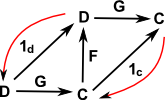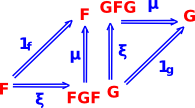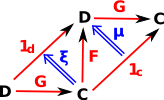When comparing objects it is often more interesting when two sets are not identical but preserve some form of structure when mapping between them.
![]()
| relative strength | type and category notation | description | ||||
|---|---|---|---|---|---|---|
| tightest | Equality | C and D are the same in these terms | ||||
| Isomorphism 1d = GF FG = 1c |
There must be an arrow and inverse between the objects and when composed these give the identity map for every element. | |||||
| Equivalence 1d FG |
For equivalence there is a arrow in both directions between the two objects. It is not necessary that GF and FG are the identity elements but they must be isomorphic to the identity elements. |
|||||
| loosest |
|
For adjunctions there is a arrow in both directions between the two objects. It is not necessary that GF and FG are the identity elements but only that they have natural transformations to the identity elements. FG is unit (does not change object - injective followed by surjective) but GF does change object (surjective followed by injective). Like equivalence but in one direction. Alternative definition: there is an isomorphism: |
Equivalence Relations
In a less category specific approach to binary relations they may, or may not, have the following properties:
| Equivalence Relation | Group | |||||||
|---|---|---|---|---|---|---|---|---|
| x |
||||||||
| transitive |
|
|||||||
| reflexive | x |
|||||||
| symmetric |
|
Comparison of Sets
Here we investigate this comparisons with the simplest concrete categories - sets.
type of |
Sets | GF |
|---|---|---|
| Equality |  |
 |
| Isomorphism 1d = GF FG = 1c |
 |
 |
| Equivalence 1d FG |
 |
|
| Adjunction |
|
|
More Detail







